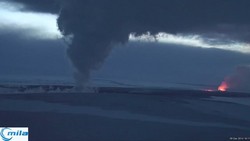100 days of gas release at Holuhraun
Gas rich but not as Laki in the 18th century
The ongoing eruption at Holuhraun, which began in at the end of August 2014, is very rich in gas. We have to go 150 years back to find an event (Trölladyngja) that had a comparable impact on Iceland and its inhabitants, in terms of environmental and health issues.
The Icelandic Meteorological Office (IMO) monitors gas releases from Holuhraun using DOAS and FTIR instruments for the estimation of SO2 flux and amount of other components in the volcanic cloud. The more abundant gases present are SO2, CO2, HCl, HF, H2O.
In the first month and half we had an averaged flux equal to 400 kg/s (~35 kT/d) with peaks up to 1300 kg/s (~112 kT/d). Assuming a constant release of gas until today, the eruption has injected into the atmosphere an amount of SO2 in the range 3.5 Mt (considering the average flux) – 11.2 Mt (considering the peak).
These numbers could be compared with the largest gas-rich eruption which occurred in Iceland in 1783-1784 (Laki eruption, Skaftáreldar, Móðuharðindin) and lasted 8 months. It has been estimated that during that eruption up to 122 Mt of SO2 were released into the atmosphere. Assuming a constant gas flux during the 8 months, the Laki eruption injected ~51 Mt in 100 days (5 - 15 times the Holuhraun‘s amount).




